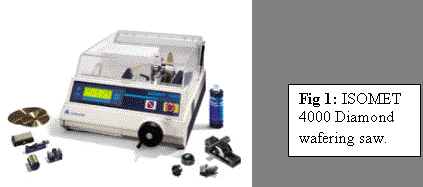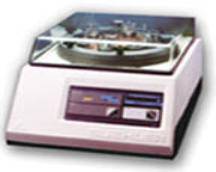Petrography
Principle
Petrography is the study of rocks and minerals using a microscope. Traditionally, petrography was limited to the identification of rocks, minerals and ores and to the characterization of properties such as cleavage, twinning and reflectance. Today, petrography techniques are employed to analyse many materials other than minerals. These materials include ceramics, glass, concrete, cement, soils, biomaterials and polymers.
Test Procedures
In order to carry out a petrographic analysis, two types of specimen are prepared:
- thin sections
- polished bulk specimens
To prepare a polished bulk specimen or a thin section, the specimen must be subjected to a series of steps consisting of sectioning, impregnation, encapsulation, grinding, and polishing.
a) Sectioning
Sectioning is the first step in the specimen preparation process and is performed for the following reasons:
- To obtain a manageable size specimen from a parent material
- To reduce the thickness of the specimen so that grinding time is reduced
- To expose the surface of interest

Fig 1: ISOMET 4000 Diamond wafering saw.
Diamond wafering saws (Fig.1) are ideal for cutting sensitive materials. Choosing the blade for the saw is also important. As a general rule, the quality of the surface finish is proportional to the abrasive size on the blade. For example, the 20HC will cut faster, but it will also produce a rougher surface than the 10LC blade.
b) Encapsulation
Once a specimen has been cut, it should be thoroughly cleaned and dried. Materials that may have pores and cracks, or are poorly consolidated, must be vacuum impregnated with epoxy. The curing rate for the epoxy can be accelerated by placing the specimen in an oven or in a hotplate. The temperature of the oven or the hot plate and epoxy should not exceed 45-50°C. Once the epoxy is completely cured, the specimen is ready for grinding.
c) Grinding
Grinding is performed to remove deformation induced in sectioning and to flatten the surface. Grinding is generally performed using either fixed abrasives where the abrasive particles are bonded to a substrate and are not free to move; or by loose abrasives where the abrasive particles are not bonded to a substrate but are free to roll around as they abrade the surface. This latter procedure is often called lapping.
d) Polishing
The purpose of polishing a specimen is to remove the final deformation induced by the grinding process and yield a surface that is essentially damage-free. The polishing time will vary depending upon the size of the abrasive used, force applied, polishing time and the wheel speed. As a rule, use diamond abrasives and hard polishing cloths in the initial stage of polishing and then switch to a softer abrasive, such as alumina or colloidal silica, for the final step of polishing on a soft cloth.

Fig.2: VIBROMET polisher used to remove deformations caused by grinding process.
The Vibromet polisher (Fig. 2) can be used to obtain ultra-thin sections. The vibratory polishing method is very gentle and removes material very slowly. Generally, specimens are polished with fine abrasive, such as 1um diamond, on a TEXMET pad, or with sub-micrometer size alumina on a MICROCLOTH pad.
Applications
The three principal rock groups of igneous, sedimentary and metamorphic may be examined and classified using petrological techniques. These techniques can similarly be used to provide valuable information concerning the characteristic minerals and structures occurring within the concrete. Microscopical analysis permits observations on:
- Aggregate
- Cement type
- Cement content
- Water/cement ratio
- Carbonation
- Cracking
- Porosity and permeability
Concrete can suffer from a variety of problems for which petrography can be usefully employed in diagnosis. Concrete defects that can be diagnosed using petrography include:
- Alkali aggregate reactivity
- Shrinkable aggregates
- Sulphate attack
- Frost susceptible aggregates
- Reinforcement corrosion
- Drying shrinkage
- Leaching
Advantages
Petrographic analysis has long been used to reveal the microstructure of ores, minerals and rocks. Further, this procedure can be very successfully used to analyze many other materials, such as concrete, cement, ceramics refractories, biomaterials and polymers. Specimen preparation can provide a wealth of information for microscopical analysis of various materials. It is up to us to do it correctly, so that erroneous conclusions are not drawn because of poor specimen preparation practices.
Limitations
The petrographic examinations include identifications of alkali-silica gel and the reactive aggregate components. The technique involves treating the surface of conditioned concrete with a solution of uranyl-acetate observing the treated surface exposed to short-wave ultraviolet light. Uranyl-acetate is a hazardous material that requires special handling and disposition. Ultraviolet light is hazardous to eyes and skin.